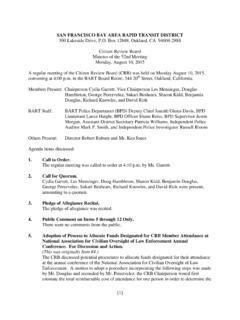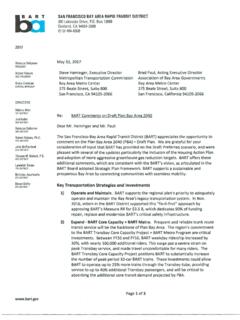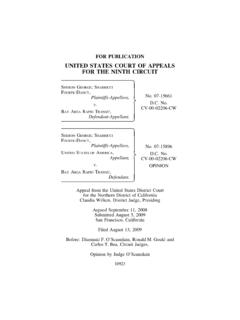Transcription of Counsel for Plaintiff and the Putative Class *Pro hac …
1 Class ACTION COMPLAINT CASE NO. 1 2 3 4 5 6 7 8 9 10 11 12 13 14 15 16 17 18 19 20 21 22 23 24 25 26 27 28 Eve-Lynn Rapp* Nina Eisenberg (SBN 305617) EDELSON PC 123 Townsend Street, San Francisco, California 94107 Tel: Fax: Counsel for Plaintiff and the Putative Class *Pro hac vice admission to be sought UNITED STATES DISTRICT COURT NORTHERN DISTRICT OF CALIFORNIA OAKLAND DIVISION PAMELA MORENO, individually and on behalf of all others similarly situated, Plaintiff , v. SAN FRANCISCO BAY area rapid transit DISTRICT, a public entity, ELERTS CORP.
2 , a Delaware corporation, Defendants. Case No. Class ACTION COMPLAINT FOR: (1) Violations of the Cellular Communications Interception Act; (2) Violations of the Consumers Legal Remedies Act; (3) Violations of Privacy Rights Pursuant to the California Constitution Article I, Section 1; and (4) Intrusion Upon Seclusion DEMAND FOR JURY TRIAL Class ACTION COMPLAINT Plaintiff Pamela Moreno ( Plaintiff or Moreno ) brings this Class Action Complaint ( Complaint ) against Defendants San Francisco Bay area rapid transit District ( BART ) and Elerts Corp, ( Elerts ) (together, Defendants ) based on their clandestine collection of private cell phone identifiers.
3 Plaintiff , for her Complaint, alleges as follows upon personal knowledge as to herself and her own acts and experiences and, as to all other matters, upon information and belief, including investigation conducted by her attorneys. Case 4:17-cv-02911 Document 2 Filed 05/22/17 Page 1 of 2617-cv-2911 Class ACTION COMPLAINT 2 CASE NO. 1 2 3 4 5 6 7 8 9 10 11 12 13 14 15 16 17 18 19 20 21 22 23 24 25 26 27 28 NATURE OF THE ACTION 1. According to the Pew Research Center, 95% of Americans own a cellphone, with more than 77% owning a smartphone.
4 Cellphone adoption and usage is so great that Americans treat them like body appendages, carrying phones on their persons at all Such ubiquity has brought about previously unheard of privacy issues, including the near constant ability for the location of cellular devices and their owners to be tracked. 2. This is particularly concerning when governmental agencies, such as law enforcement, track cellular phones and their owners, en masse. One method used by law enforcement departments across the country to track persons in that way is through the use of international mobile subscriber identity-catching devices, also known as Stingray devices.
5 With these identity-catching devices, operators mimic legitimate cell towers, causing any cellphone in range to disclose their unique cellular identifying number but leaving persons caught in the identity-catching device scheme ignorant that they are being monitored. 3. The California Legislature was cognizant of the threat posed by governmental agencies unchecked power to track a phone s unique numeric identifier and its physical location. 2 The Legislature identified major policy concerns stemming from governmental tracking, including that it raises important constitutional questions about dragnet-style general searches and their prohibition by the Fourth Amendment.
6 3 To bring transparency to these dragnet-style devices, in 2015, the Legislature passed the Cellular Communications Interception Act, Cal. Gov t Code 53166 (the Act ), which requires governmental agencies to implement a usage and privacy policy that is conspicuously posted online, among other things. 4. Unfortunately, BART, a regional governmental agency, and Elerts, a private software developer that focuses on making safety and security reporting apps, have released a 1 Americans cellphone use nearly constant | Pew Research Center, (last visited May 18, 2017).
7 2 Id. 3 Id. Case 4:17-cv-02911 Document 2 Filed 05/22/17 Page 2 of 26 Class ACTION COMPLAINT 3 CASE NO. 1 2 3 4 5 6 7 8 9 10 11 12 13 14 15 16 17 18 19 20 21 22 23 24 25 26 27 28 mobile application masquerading as a transit app that secretly collects Californians unique cellular numeric identifiers and physical locations. Through their BART Watch mobile application (the BART Watch App or App ) available for free download in the Google Play store, Defendants have convinced tens-of-thousands of Californians to download the app to keep up with transit alerts, report incidents (anonymously or not), and to call the BART police with a press of a button.
8 5. However, a detailed review of the BART Watch App reveals that Defendants have been using it to secretly collect Californians unique mobile device identification numbers, including International Mobile Equipment Identity ( IMEI ) numbers and to periodically track their precise locations. To be clear, unique numeric cellular identifiers like IMEIs are not normally collected by transit apps like the BART Watch App. Indeed, Google admonishes app developers to follow certain tenets when working with Android identifiers, with the first being to #1: Avoid using hardware identifiers such as 6.
9 But by collecting the device identification numbers, locations, and other personal information, described more below, Defendants have amassed a trove of data through the App. BART, or any of the agencies it shares resources with, now have the ability to match previous non-descript numerical identifiers with personally identifying information. Operators of Stingray devices would normally see only unique cellular identifiers without any other personally identifiable information associated ( , name or email) with the numbers. See Figure 1.
10 But by collecting tens of thousands of IMEIs along with other identifying information, it is possible to deanonymize that data. See Figure 2. * * * 4 Best Practices for Unique Identifiers | Android Developers, (last visited May 18, 2017.) (emphasis in original). Case 4:17-cv-02911 Document 2 Filed 05/22/17 Page 3 of 26 Class ACTION COMPLAINT 4 CASE NO. 1 2 3 4 5 6 7 8 9 10 11 12 13 14 15 16 17 18 19 20 21 22 23 24 25 26 27 28 (Figure 1, showing actual sample Stingray data with IMEIs circled in red.)














